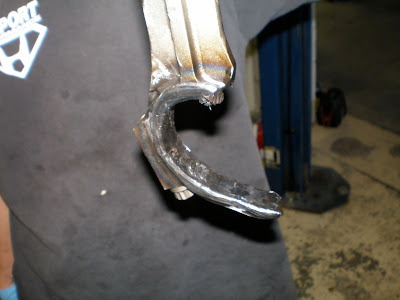Although we were well on the way to building a 1.9 liter B-series engine for the CRX, the car magazines were starting to pay increasing attention to the K-series swaps. Hasport already had three successful K-series swaps kits on the market for EG Civics, EK Civics and DC2 Integras plus there was a lot of talk on the interwebs about doing a K-swapped EF. Earlier in the year when we were prototyping the H22 mounts in the red CRX I quickly tried the K20 in the engine bay, so I knew it could fit.
So the B19 was shelved and a K20 was wheeled in for prototyping the engine mounts. Although I knew it would fit, it wasn't really a good fit. K-series engines are tall. The K20 is taller than an H22 by almost 1.75 inches, and a K24 is even taller by another .75 inches. To keep the oil pan from smacking into the ground we designed the mount kit for the shorter K20. Of course when we did our swap, there was no way I was going to settle for the 2.0, not after driving the supercharged K24 powered EP3 for the last year.
Back in the 70's when I was first getting into cars, an engine sticking out of a hood was a regular thing. If you saw a set of dual quad carbs on a high-rise manifold sticking out of the hood, you knew the car meant business. So as far as I was concerned the added impact of a K-series with supercharger sticking out of the hood of the CRX was the right message. Even to this day, you gotta admit it's pretty damn cool looking.
Back in the 70's when I was first getting into cars, an engine sticking out of a hood was a regular thing. If you saw a set of dual quad carbs on a high-rise manifold sticking out of the hood, you knew the car meant business. So as far as I was concerned the added impact of a K-series with supercharger sticking out of the hood of the CRX was the right message. Even to this day, you gotta admit it's pretty damn cool looking.
This was the first K-series engine to find it's way into the CRX. It was a K24A1 with K20A2 head. It pumped out about 280 HP. The first event this car went to was the Super Street Eurotuner Time Attack in November of 2004 where it finished first in the Limited FWD class with Rich Hayes driving.
After that first K24 went in several others followed. Next was an AEBS sleeved monster motor with Pauter Rods, JE Pistons, Eibach valve springs, IPS cams, the JR supercharger, custom SC pulley, DC sports header, MagnaFlow exhaust and two huge bottles of Nitrous courtesy of Nitrous Express. On the Supercharger alone the car made about 350 HP and with nitrous 450 HP. The engine was detuned slightly for the Sport Compact Car's Ultimate Street Car Challenge because on street tires anything over 400 HP was flat out undrivable.
Later in the year at the third Super Street Time Attack, this engine met an unfortunate and early demise as the bottom end decided it had had enough of racing. The postmortem wasn't conclusive, but one of the rods decided it didn't want to push the piston up and down anymore and mowed through the block. The moment of destruction was caught on tape by Joe Flores of K20 engine swaped Fit fame. The video is below, expletives have been beeped out to protect delicate ears.
The pictures still make me want to cry. *sniff sniff* This all happened a couple of days before the American Touge 3 filming so a quick replacement was needed. This time we opted to go cheap and bought a CRV engine. We took a bit of a hit on horsepower with that swap, from 350 down to 278 HP. That was OK though, the Touge test driver was complaining about too much horsepower. Imagine that, too much horsepower.
That's basically how the car sits now. The only other improvements were some Skunk2 K20A3/K24 Stage 2 cams. That brought the horsepower back up to 300, thank you very much. But now it's time to make some improvements. This time we are going to address the two biggest complaints of the Jackson Racing Superchargers – belt slippage and intake air temps. I got a hold of some super trick parts to test on the supercharger, a cog belt drive kit and adapter for intercooling the supercharger. Heh, heh, heh, stay tuned.









